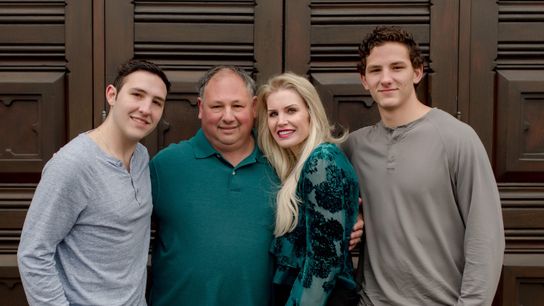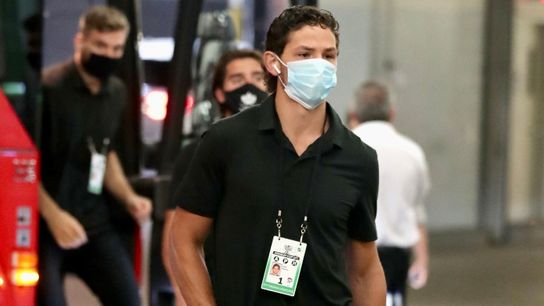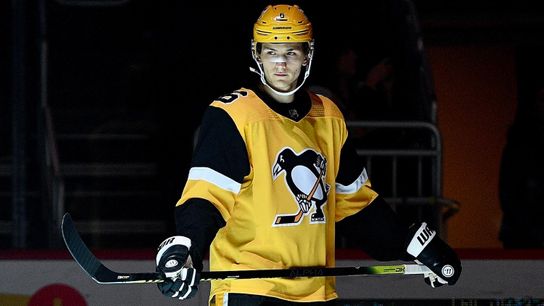Scott Young sat in the back yard of Bill Guerin’s home, eager to meet with the Penguins’ top decision makers.
It was the second day of staff meetings in the spring of 2019. Guerin, the club’s assistant general manager at the time, had volunteered to host a cookout at his Pittsburgh residence. Food and drink were plentiful. Relaxed atmosphere aside, Young was like a salesman camped out in the lobby of a corporation waiting to make an important pitch.
Young is the Penguins’ director of player development. For two years, he had been charting the progress of Harvard junior John Marino, whose rights were held by the Oilers but whose future lay elsewhere. It was an open secret the lanky right-shot defenseman would not be signing with Edmonton, and his date to hit the open market -- Aug. 15, 2019 -- was rapidly approaching.
Marino didn’t compile big offensive numbers and his talents were obscured playing in the shadow of Hobey Baker Award finalist and fellow Harvard defenseman Adam Fox. It’s why there was little buzz surrounding his impending departure from the Oilers. But Young loved Marino’s efficient style and thought him a good fit for the Penguins. He wasn’t alone in that opinion. Special assignment scout Kevin Stevens, who had a personal connection to the family, and northeast amateur scout Frank Golden also saw the potential.
"We've had hits and misses like anyone, but we really felt strongly about Marino,” Young said.
On the first night of the season-ending meetings, Young spoke briefly to general manager Jim Rutherford and coach Mike Sullivan about the defenseman while dining at a Market Square restaurant. It was during the cookout, however, where Young made his closing argument.
When the general manager signaled for Young to join him on an outdoor couch, he asked Stevens and Golden to come along. Young didn’t hold back in his assessment. He told Rutherford and Sullivan that Marino could be a top-5, maybe a top-4 defenseman for the Penguins. For the upcoming season.
“You're putting your neck on the line, but that’s how confident all three of us felt,” he said.
Young played 17 NHL seasons and won two Stanley Cups. Stevens played 15 NHL seasons, won two Cups and made three All-Star Game appearances.
Unlike the rest of us, pro athletes are relatively young when they retire. Many spend the rest of their lives looking for adrenaline rushes to fill the void. In the world of scouting, uncovering buried treasures like a John Marino qualifies.
By now, the Penguins' fans know the highlights of the story. The club traded a sixth-round pick in the 2021 NHL Draft for Marino, who made the Penguins' roster out of training camp and enjoyed a fine first season of six goals, 20 assists and a plus-17 rating in 56 games. On Monday, Marino finished eighth in Calder Trophy balloting among an exemplary rookie class, and he likely would've finished higher had he not missed a month late in the season after being struck in the eye by a puck.
Such deals rarely come together overnight. There’s a ton of legwork, detailed reports and mitigating circumstances that go into the decision. When Young left the cookout that night, he wasn’t sure how Rutherford would proceed.
“It gets nerve-wracking,” Young said. “We wanted the player so bad, but we had to wait to see if Jim could pull the deal off.”

MARINO FAMILY
Paul III, Paul Jr., Jennifer, John Marino
‘ZERO MAINTENANCE KID’
It’s funny how little images linger in the minds of hockey dads.
Paul Marino Jr. vividly recalls Young attending his son’s hockey games during his sophomore season at Harvard. Young, based in central Massachusetts, was in his first season as the Penguins' director of player development.
Paul Marino can still picture Young furiously scribbling notes in a pad.
“He was writing stuff down so hard I almost felt sorry for the sheet of paper,” the father said. “I had no idea if he was watching John or other guys.”
In Young’s profession, he must catalog the play of any skater or goalie with NHL potential. General managers are constantly churning rosters and mulling possible trades. If a rival team is offering a prospect in a potential deal, it’s Young’s responsibility — and that of his scouts — to provide a comprehensive evaluation of the player.
As a freshman and sophomore, John Marino wasn’t entertaining serious thoughts of leaving the Edmonton organization. It didn’t mean Young wasn’t filing reports on the defenseman’s game.
“You could see how efficient he was at getting pucks out of his own end and how willing he was to defend,” Young said. “You could also see what a strong skater he was. How quickly he could win a battle and escape a forecheck when he was under pressure and transition it the other way.”
Fox and Reilly Walsh provided the eye candy for scouts on the Harvard blue line. They finished last season as the team’s top two leading scorers.
As one former NHL executive said, “Marino plays such a quiet game, you could miss all the good things he’s doing if you weren’t paying close attention.”
Young estimates he saw Marino play 20 games over his final two seasons at Harvard. Each time, he left the rink more convinced the Oilers’ 2015 sixth-round draft pick was a future NHL defenseman.
Stevens had an even larger dossier on Marino. The 55-year-old former Penguins winger has known the family since John and his twin brother Paul III were kids playing youth hockey in the Boston area.
Marino and Stevens are the answers to a delicious bit of franchise trivia: Name the current and former Penguin who were born in the same Brockton, Mass., hospital?
“We can’t say enough great things about Kevin and what he’s meant to our family,” Marino’s father said. “It feels like he’s always been there for us.”
The journey began at home. The legs of Paul III were bowed 120 degrees at birth. One doctor offered an unusual recommendation: The family should take the young boy ice skating three times a week. The activity helped straightened Paul III’s legs and, where John was concerned, fueled both brothers’ obsession with hockey and put them in the orbit of a Penguins’ legend.
Stevens began coaching his son, Luke, on a youth team that included Marino in his early teens and two other future NHL players, Noah Hanifin and Colin White. After aiding in Marino’s early development, Stevens resurfaced a decade later in his current role, which involves tracking college players whom the Penguins might acquire in trades or sign as undrafted free agents.
It wasn’t long before Stevens and Young were showing up at Harvard games together.
“The good thing about me and Scotty is we see the game the same way,” Stevens said. “I haven’t always worked with scouts who see the game the same way. But Scotty and Golden saw the same things in Johnny. Really smart. Really strong on his skates. His gap control was good. And, he makes these little passes to help his team get out of trouble. On top of all that, he’s a zero maintenance kid.”
DOING THE HOMEWORK
Rutherford recalls seeing Marino’s name appear in scouting reports for the first time during the 2017-18 NHL season.
The architect of back-to-back Cup wins in 2016-17, Rutherford was searching for ways to keep the championship window open. It’s often resulted in sacrificing high draft picks and prospects to add veteran players. What Rutherford needed was high-quality, low-cost contributors. Those aren’t easy finds for cap-strapped contenders. He kept reading the glowing assessments of Marino, but knew the young defenseman was the Oilers’ property.
All teams monitor prospects from other organizations. The Penguins realized Edmonton had a pool of promising defensemen in Ethan Bear, Evan Bouchard, Caleb Jones and Marino.
The Oilers’ scouting department was encouraged by Marino’s progress, and not too concerned with his lack of offensive production (seven goals, 35 assists in three seasons at Harvard). Playing behind Fox and Walsh meant few power-play opportunities. But Marino was seen as having a future in the NHL.
On Jan. 23, 2019, that future was altered. Edmonton fired general manager Peter Chiarelli, the man who drafted Marino and had a connection to the family from his days in Boston. Suddenly, the strongest advocates for Marino within the organization were either gone or headed out the door.
The Marinos were well aware of the stipulation in the collective bargaining agreement that allowed college players to become free agents after four years from the time they were drafted. The family began doing extensive research, spearheaded by Paul III, a Harvard statistics major with a budding career in analytics. They looked for the best possible free-agent landing spots, particularly on American rosters. Pittsburgh was among the most enticing options.
But according to one source, there weren’t many teams interested in trading for Marino’s rights, which baffled some Edmonton insiders.
“It told you one of two things,” a source said. “Either teams hadn’t done their homework on John or they had done their homework and the information wasn’t getting to their general managers.”
Rutherford was faced with a decision. Either swing a trade for Marino ahead of the Aug. 15, 2019, deadline and try to negotiate an entry-level deal, or allow the kid to reach free agency and take the chance that their pitch would be the strongest.
“As time went along, more and more reports came back that said, ‘We really like this player,’ " Rutherford recalled. “We did not want to wait for the free-agent process to play out and see someone else grab him.”
The hands of the Oilers' new general manager, Ken Holland, were tied. He needed some return on a defenseman who was generating minimal trade interest. In the end, the Penguins were the only team to make an offer, according to a source.
Yes, the only one.
And on July 26, 2019, Pittsburgh acquired Marino for the 2021 sixth-rounder.
As one Edmonton insider put it: “It’s clear that Jimmy and the Penguins had done their homework.”
‘OPPORTUNITY OF A LIFETIME’
A college player exerting leverage to find a new organizational home is rare, but hardly unprecedented. Fox, a New York native, used the same tactic last offseason. He balked on an entry-level deal from the Hurricanes before being traded to the hometown Rangers.
The Marinos were sensitive to how their move would be portrayed. It helped that the trade barely created a ripple in the NHL news cycle. The Edmonton Journal announced the deal with this headline on its website:
Edmonton Oilers trade marginal prospect John Marino for a draft pick
The family was relieved the Oilers were able to recoup a future asset in the transaction. It allowed the Marinos to turn their full attention to John’s immediate future.
Should he stay for his senior season at Harvard, where he had been named captain, while remaining the Penguins’ property for another year?
Should he simply sign an entry-level deal with Pittsburgh?
Or should he wait a few more weeks and go to free agency?
The family hoped for a quick resolution. Nobody wanted a repeat of the Jimmy Vesey saga. The former Hobey Baker winner from Harvard was a 2012 draft pick of the Predators. After informing Nashville in 2016 of his decision to not sign an entry-level deal, Vesey saw his rights traded to the Sabres for a third-round pick. But after one meeting with Buffalo management, the college forward decided to test the free-agent market and sign with the Rangers.
Vesey’s power play drew criticism, particularly on social media. In his first trip to Nashville as a member of the Rangers, one fan at Bridgestone Arena held a sign reading: “Jimmy Vesey is a lying weasel.” He was booed every time he touched the puck.
Fortunately for the Marinos, no such controversy developed. They were thrilled with the Penguins’ trade. Not only did they have a prior relationship with Stevens, but the player’s agent, Peter Fish, had been a teammate of Young and Sullivan at Boston University.
“We just felt very comfortable with the Penguins and very appreciative of the plan they had in place for John," the father said.
The only real question was whether Marino would return to Harvard for his final season. The player’s feelings were torn. Going back to school meant spending one more year with good friends and graduating together with his brother.
Marino’s dad asked Stevens to chat with his son.
“Once we pulled that trade off, I could put the full-court press on,” Stevens said, laughing. “Once I was able to talk to him and tell him everything about our organization and how we played, I think he liked the idea. Everybody loves college, but I told him, ‘This is an opportunity of a lifetime. You will love playing in the NHL and in Pittsburgh.' ”

GETTY
John Marino with the Penguins in the Toronto bubble last month.
‘IT'S A REAL BONUS’
Everybody enjoys recognition from their peers. That includes the men and women in the scouting community, the ones who rank among the most anonymous members of a pro sports franchise.
A scout can spend years bird-dogging a prospect in Boston only to see his organization use the appropriate pick on an 18-year-old from Austria. So when Marino made the Penguins out of training camp last season and worked his way into the team’s second pair, Young, Stevens and Golden were walking a bit taller around the college rinks.
“I can’t tell you how many times this past year I had other scouts come up to me and say, ‘Did you see that John Marino was going to be this good?’ ” Young recalled. “I would tell them, ‘You never know, but we felt strongly he could be one of our top-five defensemen.’ ”
Marino's rookie performance made his brother — who next season will work in the Kings’ analytics department — swell with satisfaction. According to Natural Stat Trick, in five-on-five play, among rookie NHL defensemen who logged at least 750 minutes, Marino was tops in limiting opponents' offense at 1.8 expected goals against per 60 minutes. Among all NHL defensemen in the same category, he placed fourth. In using Evolving Hockey's wins above replacement (WAR), Marino (2.7) ranked 10th among all defensemen (>50 TOI). By comparison, Calder winner Cale Makar of the Avalanche bested Marino by a mere .1 in the same measure.
“John makes simple plays,” Young said. “With our group of forwards, it’s going to translate into offense. It has to. He puts pucks into areas that are very easy for his partner or the low forward (in the defensive zone) to get. He’s not putting them in difficult positions, and that leads to clean zone exits.”
Marino’s rapid maturation also enabled Rutherford to trade defenseman Erik Gudbranson on Oct. 25, 2019 to the Ducks. For a club desperate to shed salary, the deal allowed the Penguins to shed a contract that would have paid $4 million next season. By contrast, Marino’s cap hit is $925,000 for the 2020-21 season, according to CapFriendly.com.
“These are the type of guys we need to get,” Rutherford said. “We are in a win-now situation. We trade away a lot of our draft picks. We have to try and pick up guys like this, and when we hit on one like Marino, it’s a real bonus.”
Nothing will duplicate the joy of hoisting the Stanley Cup for former players like Stevens and Young. Those days are gone.
Yet when a general manager trusts your advice and a deal turns out as well as the one for Marino, it makes all those long nights on the road, far removed from NHL arenas, a lot more tolerable.
“That’s what we live for,” Stevens said. “We’re trying to get the players who make our team better. Credit to Jimmy, he’s the one who made the trade. But it’s really gratifying to watch how Johnny is playing. We believed in him, but he’s the one who had to do it on the ice.”

